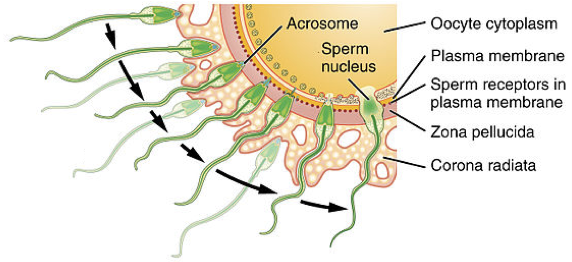Table of Contents |
Fertilization is the process in which male sperm and female egg combine genetic information, generally as a result of sexual intercourse. In this process, semen is ejaculated from the penis into the vagina and travels through the vagina, cervix, uterus and eventually into the oviduct. An oviduct (also known as the Fallopian tube) is the area where an oocyte (egg) is then fertilized by a sperm cell.
During fertilization, the acrosome (enzyme cap on the head of the sperm) will allow the sperm to penetrate the zona pellucida, which is the thick layer that surrounds the egg. Once a sperm gets inside, fertilization has occurred. Until fertilization happens, the oocyte (egg) is suspended in the middle of cell division; it is only when fertilization occurs that the oocyte completes cell division and becomes a mature ovum.

Remember that each gamete (the female oocyte and the male sperm) have only half the normal amount of DNA. The nuclei of the sperm has a total of 23 chromosomes, and the nuclei of the egg cell also has a total of 23 chromosomes. Once the sperm and egg nuclei have combined, it will have a total of 46 chromosomes (the normal amount of DNA), forming a zygote. A zygote is essentially the first true cell of an individual. The ovum, at that point, will then start to divide and begin to form an embryo.
To develop into an embryo, the zygote has to undergo divisions. Those divisions will turn this one cell into a ball of many cells, which will later specialize and develop into an embryo.
Cleavage is the term used to describe the rounds of cell division. The process of cleavage happens while the zygote is moving through the oviduct (Fallopian tube) toward the uterus. As the zygote is moving down the oviduct, it will undergo a series of divisions and eventually implant in the endometrium of the uterus once it reaches it.

During cleavage, the original zygote replicates its DNA and splits into multiple cells without changing size. Each cell that results from cleavage takes a unique portion of the zygote's cytoplasm. Because each area within the zygote has a different balance of key developmental proteins, each new cell that arises from cleavage (called a blastomere) has a unique mix of these proteins. This unique mix is like a program for each blastomere of the developing embryo, telling the cell whether to generate skin, the digestive system or blood vessels, etc.
Once the zygote has cleaved four times (into 16 blastomeres), it is called a morula (usually three to four days after fertilization). Around day five after fertilization, a fluid-filled cavity will open up in the morula, creating a thin layer of cells (the trophoblast) surrounding the cavity and an inner cell mass within the cavity, which will become the embryo. This formation, a morula that has filled with fluid and differentiated into a trophoblast and an inner cell mass, is called a blastocyst.
About a day after the blastocyst forms, it will reach the uterus. As it rolls along the endometrium, it continues to develop. Roughly nine days after fertilization, the blastocyst will undergo gastrulation.
Gastrulation is a process that occurs after cleavage that rearranges the cells of the blastocyst into three tissue layers called germ layers. The three germ layers in a developing embryo are:

The ball of 16 cells gets rearranged into these different germ layers, which will differentiate into all of our tissues and organ systems.
Each germ layer is going to differentiate through a process called cell differentiation, which is when the cells become specialized (that is, they form different tissues with specific jobs). This process of cell differentiation is called morphogenesis, which is when the tissues and organs form as the cells began to become specialized. One cell might develop into a nerve cell, which composes the nervous system or one type of cell might develop into a cell that becomes a part of your skin.
Source: THIS WORK IS ADAPTED FROM SOPHIA AUTHOR AMANDA SODERLIND.